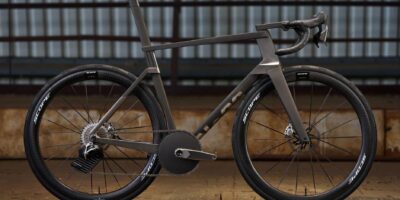Triathlon aerodynamics differ significantly from road racing. You’re riding alone, maintaining steady power, and every watt saved directly translates to faster swim-to-run transitions. Here’s how to optimize your triathlon or time trial bike for maximum aerodynamic efficiency in 2025.
The Triathlon Aero Stack: Prioritized Upgrades
Position First: The 30-Minute Investment That Saves 50 Watts
Before spending a dollar on equipment, optimize your position. A professional aero fit typically costs $300-500 but can yield:
- Hip angle optimization: 15-25 watts saved by opening hip angle slightly while maintaining aero profile
- Arm pad placement: 10-15 watts from proper elbow width and pad height
- Helmet-to-back alignment: 5-10 watts by creating smooth airflow from helmet to back
Pro tip: Many fitters now use software like MyVeloFit or Retül to test positions in real time, showing power and CdA (coefficient of drag) changes instantly.
Essential Aero Equipment for Triathlon
1. Aero Bars: The Foundation ($200-$1,200)
Unlike road racing, triathlon allows you to stay in the aero position for the entire bike leg. Your bar choice dramatically affects comfort and speed.
Best Value: Profile Design Sonic/Ergo ($349) – Proven reliability, comfortable pads, infinite adjustability.
Premium Choice: Vision Metron 5D ACR ($599) – Integrated computer mount, exceptional stability, used by pros.
Top-End: CADEX Aero TT ($1,100) – Computational fluid dynamics optimized, lightest option at 520g.
2. Triathlon-Specific Wheels ($1,200-$4,000)
Tri wheels need to handle crosswinds while solo (no peloton draft) and work with disc brakes on most modern bikes.
Front Wheel (60-80mm depth):
- Budget: Zipp 404 ($950) – Crosswind stable, proven performance
- Premium: ENVE 7.8 ($1,575) – Lighter, stiffer, UCI Hour Record proven
Rear Wheel (Disc or 80-90mm):
- Budget: HED Jet Disc+ ($1,200) – Durable, aero, works in wind
- Premium: Zipp Super-9 Carbon Clincher Disc ($1,650) – Lightest disc wheel available
3. Aero Helmet: Purpose-Built for Triathlon ($200-$450)
Triathlon helmets with tail designs work because you hold one position. Road aero helmets compromise for head movement.
Top Choices:
- Giro Aerohead MIPS ($275): Best-selling tri helmet, proven in Kona, MIPS safety
- POC Tempor ($400): Wind tunnel champion, magnetic visor, premium comfort
- Kask Mistral ($350): Italian design, excellent ventilation for hot races
The Marginal Gains: 5-Watt Improvements
Hydration and Nutrition Storage
Every bottle creates drag. Modern tri bikes integrate storage aerodynamically:
- Between-the-arms bottle system: Profile Design or XLAB systems place hydration in the low-pressure zone behind your head
- Frame-integrated storage: Specialized Shiv, Cervélo P-Series, and Canyon Speedmax hide bottles and gels inside the frame
- Bento box: Top tube storage for nutrition adds minimal drag compared to jersey pockets
Combined savings: 8-12 watts vs. traditional bottle cages
Clothing: The Skin Suit Advantage
A quality triathlon skin suit saves 15-20 watts versus traditional cycling kit:
- Budget: dhb Blok Aeron ($110) – Great value, wind tunnel tested
- Mid-range: Castelli San Remo 4.0 ($280) – Pro peloton proven
- Premium: Bioracer One Speedsuit Aero ($350) – Custom fit, maximum speed
Shoe Covers and Aero Socks
Often dismissed, but foot area creates significant drag:
- Aero shoe covers: 3-5 watts saved
- Aero socks (Vorteq, Aero.Fit): 1-2 watts saved
The Complete Triathlon Aero Package
Budget Build ($2,500 total)
- Aero fit session: $400
- Profile Design aero bars: $350
- Giro Aerohead helmet: $275
- Zipp 404 front wheel: $950
- HED Jet disc rear: $1,200
- Hydration system: $150
- Skin suit: $175
- Expected savings: 80-100 watts
Performance Build ($6,500 total)
- Premium aero fit with follow-up: $600
- Vision Metron 5D ACR bars: $600
- POC Tempor helmet: $400
- ENVE 7.8 front + Zipp Super-9 rear: $3,200
- Integrated hydration system: $400
- Bioracer custom skin suit: $350
- Shoe covers + aero socks: $150
- Frame storage (bento, bottles): $200
- Expected savings: 120-140 watts
Real-World Time Savings
To put watt savings in perspective for common triathlon distances:
Olympic Distance (40km bike):
- 50 watts saved = ~2:30 faster
- 100 watts saved = ~5:00 faster
Half Ironman (90km bike):
- 50 watts saved = ~6:00 faster
- 100 watts saved = ~12:00 faster
Full Ironman (180km bike):
- 50 watts saved = ~12:00 faster
- 100 watts saved = ~24:00 faster
Testing and Validation
Don’t guess – test your setup:
- Velodrome testing: Controlled environment, repeatable tests, $200-400 per session
- Chung method: Free power-based aero testing on outdoor courses using Golden Cheetah software
- Wind tunnel: Ultimate validation but expensive ($500-1,500 per session)
Conclusion: The Triathlon Aero Checklist
For maximum speed in 2025:
- Get a professional aero fit (biggest bang for buck)
- Invest in quality aero bars that you can hold comfortably for hours
- Choose wheels appropriate for your race conditions (windy vs. calm)
- Wear a proper triathlon aero helmet with tail design
- Integrate hydration and nutrition aerodynamically
- Wear a skin suit, not traditional cycling kit
- Test your setup and validate improvements
By following this hierarchy and investing strategically, you can achieve 90% of maximum aero performance at 40% of the cost of the absolute cutting edge. More importantly, you’ll be faster, more comfortable, and better positioned to run well off the bike.



